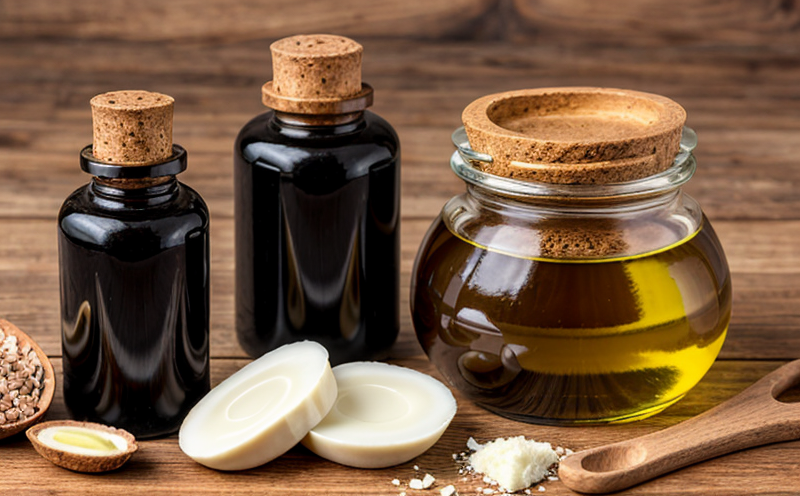AOAC 996.06 Fatty Acid Profile Analysis in Oils
The AOAC International (Association of Official Analytical Chemists) Method 996.06 is a widely recognized standard for the determination of fatty acid profile in oils and fats. This method provides comprehensive information about the composition of triglycerides, which are essential for ensuring product quality, safety, and compliance with industry standards.
The AOAC 996.06 procedure involves the hydrolysis of triglycerides to free fatty acids using an aqueous potassium hydroxide solution followed by their subsequent derivatization and quantification via gas chromatography (GC). This technique ensures accurate measurement of individual fatty acid components, enabling detailed analysis of both saturated and unsaturated fats present in various edible oils.
Edible oils form a crucial component of the global food industry. They play an integral role not only in enhancing flavor but also in providing essential nutrients such as omega-3s, vitamin E, and antioxidants that contribute significantly to human health. The composition of these fats can vary widely depending on factors like plant species used during extraction or processing methods employed post-harvest.
By employing this standardized approach, laboratories can offer reliable data regarding the fatty acid profiles of different types of edible oils including olive oil, sunflower seed oil, corn oil, soybean oil, peanut oil, and others. Such detailed analyses are particularly important when sourcing raw materials for manufacturing processes where consistency in product quality is paramount.
The importance of maintaining accurate records cannot be overstated; they serve as critical documentation supporting claims made about nutritional content or health benefits associated with specific products derived from these sources. Compliance with regulatory requirements ensures consumer confidence and trust while mitigating potential risks related to adulteration or mislabeling issues.
Our laboratory adheres strictly to this methodology ensuring precise results that meet the highest standards of accuracy and reliability. By leveraging state-of-the-art facilities equipped with advanced chromatographic instrumentation, our team delivers timely reports which can be instrumental for quality assurance programs within organizations involved in food production or supply chain management.
Applied Standards
The AOAC International Method 996.06 is based on internationally recognized standards such as ISO (International Organization for Standardization), ASTM (American Society for Testing and Materials), EN (European Norms) and IEC (International Electrotechnical Commission). These organizations ensure consistency across various testing procedures worldwide, thereby facilitating seamless trade between countries.
Our commitment to adhering strictly to these guidelines ensures that all analyses conducted at our facility are accurate, reproducible, and comparable with those carried out by other reputable laboratories around the globe. This standardization also supports continuous improvement efforts aimed at enhancing overall analytical capabilities within the organization.
Eurolab Advantages
When choosing Eurolab for your fatty acid profile analysis needs, you can expect unparalleled expertise in this field. Our team comprises experienced chemists and analysts who possess extensive knowledge of current methodologies and best practices related to lipid chemistry.
We pride ourselves on delivering accurate, timely results that exceed expectations set forth by industry standards. With our state-of-the-art laboratory facilities housing the latest chromatographic equipment, we ensure every sample receives optimal treatment under controlled conditions.
Our commitment extends beyond mere testing; it includes providing detailed reports tailored specifically to meet your unique requirements whether you're looking for simple confirmation of compliance or in-depth insights into complex mixtures. By partnering with Eurolab, businesses can gain valuable knowledge that aids decision-making processes throughout their supply chain operations.
Use Cases and Application Examples
| Use Case | Description |
|---|---|
| Quality Assurance & Control | Monitoring consistency across batches of processed oils ensures uniformity in product quality. Regular analysis helps identify any deviations early on so corrective actions can be taken promptly. |
| New Product Development | Prior to launching new products, companies often conduct thorough testing using AOAC 996.06 to understand the baseline characteristics of their raw materials. This information guides formulation decisions aimed at creating innovative offerings. |
| Supplier Evaluation | Determining compliance with specifications laid down by contract agreements is vital when selecting reliable suppliers for ongoing purchases. Our tests provide objective evidence supporting supplier selection criteria. |
| In-Process Monitoring | During manufacturing processes, periodic checks using this method help ensure continuous adherence to specified limits. This proactive approach prevents costly mistakes further down the line. |
| Custom Formulations | For customers seeking customized blends of oils tailored specifically to meet particular nutritional goals or sensory preferences, precise measurement of fatty acid profiles becomes essential. |
| Product Labelling Compliance | To comply with labeling regulations that require disclosure of certain fatty acids present in finished goods, accurate analysis using AOAC 996.06 provides the necessary data points for declaration purposes. |
| Research & Development | Scientists involved in research projects focused on improving extraction techniques or developing novel purification methods benefit greatly from having reliable baseline data about starting materials. |





